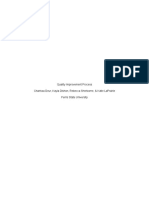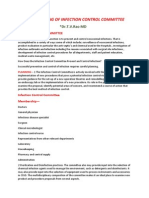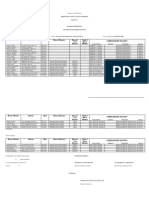Quality and Safety Synthesis Paper
Quality and Safety Synthesis Paper
Uploaded by
api-252807964Copyright:
Available Formats
Quality and Safety Synthesis Paper
Quality and Safety Synthesis Paper
Uploaded by
api-252807964Original Title
Copyright
Available Formats
Share this document
Did you find this document useful?
Is this content inappropriate?
Copyright:
Available Formats
Quality and Safety Synthesis Paper
Quality and Safety Synthesis Paper
Uploaded by
api-252807964Copyright:
Available Formats
Running head: QUALITY AND SAFETY
An Examination of Quality and Safety at Bayfront Health
Marlee Griggs
Leadership and Management in Professional Nursing 4827C
November 11, 2014
University of South Florida
QUALITY AND SAFETY
2
Examination of Quality and Safety
This paper will examine how the Critical Care Unit (CCU) at Bayfront Health utilizes
quality and safety competencies to guide their patient care. A nurse manager was interviewed
using the questions provided and the answers will be discussed to determine if the care provided
is in accordance with the six quality and safety competencies chosen for this paper.
The first quality and safety competency is patient-centered care, which enables the
patient to receive care based on their values, preferences, and needs and empowers the patient to
be a full partner in the care they receive. The nurse manager for CCU explained that on his unit,
the nursing staff supports patients of different values, as long as it is not harmful to the patient.
He reported that his staff always strives to support the wishes of the patient and the family, and
that it helps when the patient has a living will. The nurse manager stated that gray areas are a
barrier to fully supporting patient-centered care, and that at times it is necessary to utilize staff
outside of nursing. The chaplain or ethics board have to be consulted in situations where there is
a difficult decision to make, and they can assist by making recommendations to the patient and
family. Working with interdisciplinary staff that supports one another ultimately allows the
nursing staff to do their best to support individuals and families with values that differ from their
own.
Teamwork and collaboration are also a part of the quality and safety competencies, and
encapsulate an interdisciplinary approach with open communication, mutual respect, and shared
decision-making. The CCU uses care-rounds on Tuesday and Thursday morning where an
interdisciplinary team makes rounds and discusses all of the patients on the unit. The team
consists of physical therapy, respiratory therapy, a clinical documentation specialist, a physician,
QUALITY AND SAFETY
pharmacy, case management, and a social worker. The physician is able to educate the nurses on
patient needs and answer any questions they might have, case management discusses patient
placement and family needs, and the social worker assists with home health or applicable
community resources. If the family is present, they are also able to ask any questions or voice
any concerns they might have while the team is present. This interdisciplinary approach to care
allows the patient and the family members to be more involved in their care, and also allows the
nurse to communicate relevant information to the health care team at one time. It also enables the
nurse to keep abreast with the plan of care for the patients and to be able to answer any further
questions the family might have.
Another quality and safety competency is the use of evidence based practice which
moves an organization from whats always been done to the use of research and best current
evidence to help lead their delivery of care. The Agency for Healthcare Research and Quality
(AHRQ) reports that research has proven when patients are engaged in their care, measurable
improvements in safety and quality can be seen. Because of this, the AHRQ has developed a
guide that focuses on four primary strategies to promote patient and family engagement, one of
which is the implementation of safe continuity of care by using nurse bedside change-of-shift
reports (AHRQ, 2013). Bayfront has followed this guideline given by the AHRQ, and one of the
major changes that has happened in the last year to reflect current best practice is the use of
bedside reporting. At shift change, the nurses are to give report to the next shift while at the
patients bedside. This change in practice gives greater autonomy to the patient in relation to
their care and also empowers them because they have a better understanding of the care they are
receiving. The use of change-of-shift reports keeps the patient and family members informed and
allows them to ask questions or voice any concerns they might have.
QUALITY AND SAFETY
Quality improvement utilizes data to monitor and measure outcomes of patient care and
then uses that information to design systematic processes to measurably improve health care
services in areas that are in need of better outcomes. One area that the CCU has analyzed and is
changing practice in is the use of foley catheters. Because there has been an increase in the
number of catheter associated urinary tract infections (CAUTI), Bayfront has formed a
committee to address this issue and has adopted the use of a maintenance bundle to decrease the
number of CAUTI incidents. The nurse manager communicated that the maintenance bundle
consists of the nurse evaluating the need for the foley catheter daily, prevention of dependent
loops in the tubing, placing the drainage bag below the level of the bladder, and daily perineal
care. The maintenance bundle has been proved through research that its use can prevent the
development of CAUTI. The committee has also developed a discontinuation protocol, and if the
patient meets the criteria for this protocol, the nurse can discontinue the catheter without a
physician order. These protocols not only reduce the number of CAUTI, but concurrently
improve patient outcomes and ensure the delivery of better healthcare services.
Safety is the fifth quality and safety competency and it focuses on reducing the risk of
harm to patients and providers. The nurse manager reported that six goals have been chosen from
the 2014 National Patient Safety Goals set forth by the Joint Commission and are being
implemented on the unit. The purpose of the National Patient Safety Goals is to improve patient
safety, identify problems in the delivery of safe healthcare, and implement solutions (Joint
Commission, 2014). The goals include: improve the accuracy of patient identification, improve
the effectiveness of communication among caregivers, improve the safety of medication use,
reduce the risk of healthcare associated infections, identify safety risks inherent to the patient
population, and follow universal protocol for preventing wrong site, wrong procedure, and
QUALITY AND SAFETY
wrong person surgery (Joint Commission, 2014). Protocols have been put in place to assist the
nurses with meeting these goals and increasing the safety of patient care. The nurse manager is
monitoring compliance with these goals and working one-on-one with staff members that need
further assistance in implementing these safety goals as part of their care.
Healthcare is increasingly moving towards informatics and the use of information
technology to help reduce error and complete tasks in a more efficient way. The nurse manager
reported that the two main issues with the Electronic Medical Records on CCU is the downtime
of the system and waiting for the provider to put in the orders. When the system is not operating
and the healthcare team is not able to access the Electronic Medical Records, they have to
transition to the use of paperwork and manually charting on the patient. The manager reported
that it is difficult to transition between the two and information can be lost in the transition. He
also reported that another difficult component is the provider not putting the orders into the
system in a timely manner. The provider may come to the floor, see all of the patients, and then
go to several other floors before they sit down to write their progress notes or add orders. This
causes the nurse to continuously check the computer for new orders to make sure they are
reviewing new orders in a timely manner so that patient care is not delayed.
Based upon the discussion with the nurse manager of CCU, it does appear that the unit
and Bayfront Health are striving to operate in accordance with the six quality and safety
competencies. Incorporating these competencies into the care that nurses and the other team
members are providing improves the overall healthcare system. All of these competencies are
designed to promote safe, high quality care for patients and their families and to design systems
that promote and encourage competent care.
QUALITY AND SAFETY
References
Agency for Healthcare Research and Quality (2013, June). Guide to patient and family
engagement in hospital quality and safety. Retrieved from
http://www.ahrq.gov/professionals/systems/hospital/engagingfamilies/
Joint Commission (2013, October 24). Hospital: 2014 national patient safety goals. Retrieved
from http://www.jointcommission.org/hap_2014_npsgs/
You might also like
- Data Makes the Difference: The Smart Nurse's Handbook for Using Data to Improve CareFrom EverandData Makes the Difference: The Smart Nurse's Handbook for Using Data to Improve CareNo ratings yet
- Stanford Journal of Public Health - Volume 1 - Issue 1 - Spring 2011Document48 pagesStanford Journal of Public Health - Volume 1 - Issue 1 - Spring 2011stanfordjphNo ratings yet
- Final Paper Nur410Document10 pagesFinal Paper Nur410api-598929897No ratings yet
- He U.S. Hospital System Suffers From ShortfallsDocument8 pagesHe U.S. Hospital System Suffers From Shortfallsjoy gorreNo ratings yet
- Core Components-Competence NursingDocument2 pagesCore Components-Competence NursingitunuNo ratings yet
- Bringing Evidence-Based Best Practices Into PracticeDocument3 pagesBringing Evidence-Based Best Practices Into PracticeJoaoNo ratings yet
- Sample Sample: Running Head: Evidence-Based Nursing Practice 1Document7 pagesSample Sample: Running Head: Evidence-Based Nursing Practice 1Henoke ManNo ratings yet
- Primary Urgent Care Guidelines UtiDocument22 pagesPrimary Urgent Care Guidelines UtiUti Nilam SariNo ratings yet
- FPX4020 WilsonChelsea Assessment4 1Document17 pagesFPX4020 WilsonChelsea Assessment4 1FrancisNo ratings yet
- Hypo FPX 4020 Assessment 3Document14 pagesHypo FPX 4020 Assessment 3Sheela malhiNo ratings yet
- ReflectionpaperDocument7 pagesReflectionpaperapi-273459660No ratings yet
- Clinical Nursing Judgment Scholarly PaperDocument6 pagesClinical Nursing Judgment Scholarly Paperapi-546488467No ratings yet
- Informatics ProjectDocument7 pagesInformatics ProjectShannon TerrellNo ratings yet
- 2.quality Assurance in NursingDocument7 pages2.quality Assurance in NursingNancy SamuelNo ratings yet
- Quality and Synthesis PaperDocument6 pagesQuality and Synthesis Paperapi-253093073No ratings yet
- Evidence Based Standards For Measuring Nurse Staffing and PerformanceDocument208 pagesEvidence Based Standards For Measuring Nurse Staffing and Performancemr_jamzNo ratings yet
- Failure To Respond Reflection2Document6 pagesFailure To Respond Reflection2stoddartoliveNo ratings yet
- Qms Project #1Document16 pagesQms Project #1GirumNo ratings yet
- Untitled DocumentDocument8 pagesUntitled Documentapi-499926602No ratings yet
- Qi Project Assignment Paper 1Document6 pagesQi Project Assignment Paper 1api-354027298No ratings yet
- Patient' Satisfaction and Quality of Healthcare: Case of Hospitals in Ho Chi Minh CityDocument16 pagesPatient' Satisfaction and Quality of Healthcare: Case of Hospitals in Ho Chi Minh CityPSAKU International Journal of Interdisciplinary ResearchNo ratings yet
- Quality Improvement ProcessDocument10 pagesQuality Improvement Processapi-284596154No ratings yet
- Safety Paper 1200Document7 pagesSafety Paper 1200sbhutto90No ratings yet
- Research Helps Nurses Determine Effective Best Practices and Improve Patient CareDocument3 pagesResearch Helps Nurses Determine Effective Best Practices and Improve Patient CareAziil LiizaNo ratings yet
- Scholarly PaperDocument6 pagesScholarly Paperapi-607036461No ratings yet
- Value of Clinical Laboratory Services in Health CareDocument4 pagesValue of Clinical Laboratory Services in Health Careapi-280296463No ratings yet
- Qsen PresentationDocument26 pagesQsen Presentationapi-235633705100% (1)
- AIDET FinalDocument44 pagesAIDET FinalMEHDI100% (1)
- Perianesthesia Nursing Standards of Practice Jennifer J SmithDocument11 pagesPerianesthesia Nursing Standards of Practice Jennifer J Smithapi-239605726No ratings yet
- Evidence Based Standards For Measuring Nurse Staffing and PerformanceDocument208 pagesEvidence Based Standards For Measuring Nurse Staffing and PerformanceA As'ad MaoNo ratings yet
- Adverse Event or Near-Miss AnalysisDocument10 pagesAdverse Event or Near-Miss Analysisjahxtow safariNo ratings yet
- Ajns 20150403 11Document5 pagesAjns 20150403 11Rahmat Ramadhan MokogintaNo ratings yet
- The Importance of Evidence-Based Practice in NursingDocument9 pagesThe Importance of Evidence-Based Practice in Nursingapi-740215605No ratings yet
- Monitoring Compliance To The Sixth IpsgDocument12 pagesMonitoring Compliance To The Sixth IpsgHosam GomaaNo ratings yet
- Running Head: NURSING STANDARDS 1Document20 pagesRunning Head: NURSING STANDARDS 1api-253509573No ratings yet
- Improving Bedside Shift-To-shift Nursing Report ProcessDocument34 pagesImproving Bedside Shift-To-shift Nursing Report ProcessJaypee Fabros Edra100% (2)
- Quality Improvement Plan - EditedDocument11 pagesQuality Improvement Plan - EditedkatkimaNo ratings yet
- Ah 16252Document6 pagesAh 16252nesquivelgNo ratings yet
- NURS-FPX4020 Assessment 1 Enhancing Quality and SafetyDocument7 pagesNURS-FPX4020 Assessment 1 Enhancing Quality and SafetyNursFpx-4000-4900No ratings yet
- Development and Implementation of A Clinical Pathway Programme in An Acute Care General Hospital in SingaporeDocument10 pagesDevelopment and Implementation of A Clinical Pathway Programme in An Acute Care General Hospital in SingaporeAisyah ShofiNo ratings yet
- Managing Change Towards Bedside Shift ReportDocument12 pagesManaging Change Towards Bedside Shift Reportapi-438607141No ratings yet
- Ghosh 2021Document6 pagesGhosh 2021Yonatan MeshaNo ratings yet
- Nur 410 Bedside Shift ReportDocument8 pagesNur 410 Bedside Shift Reportapi-448827323No ratings yet
- Case Study 1Document4 pagesCase Study 1languha NgatiNo ratings yet
- The Role of Nurse Practitioners in Care Coordination and TransitionDocument10 pagesThe Role of Nurse Practitioners in Care Coordination and Transitionapi-312364579No ratings yet
- Nursing p1Document6 pagesNursing p1Born TaylorNo ratings yet
- QsenDocument16 pagesQsenapi-239630424100% (1)
- Sample - Critical Review of ArticleDocument11 pagesSample - Critical Review of Articleacademicproffwritter100% (1)
- Critical Thinking Exercise - As A Change AgentDocument8 pagesCritical Thinking Exercise - As A Change AgentDennis Nabor Muñoz, RN,RMNo ratings yet
- Daily Goals Tools Enhancing Outcomes in A Surgical Intensive Care Unit by ImplementingDocument14 pagesDaily Goals Tools Enhancing Outcomes in A Surgical Intensive Care Unit by ImplementingAnugerah Eka PurwantiNo ratings yet
- WEEK3 EssayDocument9 pagesWEEK3 Essaycorrinesantos24No ratings yet
- Amarga Policy PaperDocument93 pagesAmarga Policy PaperAngel GarciaNo ratings yet
- Patient Safety A Literature Review To Inform An Evaluation of A Maternity ServiceDocument5 pagesPatient Safety A Literature Review To Inform An Evaluation of A Maternity Servicetdqmodcnd100% (1)
- Cat 23 0366Document18 pagesCat 23 0366JoséBerriosNo ratings yet
- @EVIDENCE BASED PRACTICE - EditedDocument5 pages@EVIDENCE BASED PRACTICE - EditedSir Ben MwauNo ratings yet
- Leadership AnalysisDocument8 pagesLeadership Analysisapi-260554694No ratings yet
- NURS 682 Care Coordination and Role of The Advanced Practice NurseDocument3 pagesNURS 682 Care Coordination and Role of The Advanced Practice NurseParya VNo ratings yet
- Clinical Nursing Judgment Senior Capstone - Emerson Fletcher - FinalDocument6 pagesClinical Nursing Judgment Senior Capstone - Emerson Fletcher - Finalapi-660321588No ratings yet
- Health Care Delivery Manager- The Comprehensive Guide: Vanguard ProfessionalsFrom EverandHealth Care Delivery Manager- The Comprehensive Guide: Vanguard ProfessionalsNo ratings yet
- Medical Utilization Review Coordinator - The Comprehensive Guide: Vanguard ProfessionalsFrom EverandMedical Utilization Review Coordinator - The Comprehensive Guide: Vanguard ProfessionalsNo ratings yet
- The Maximally Efficient and Optimally Effective Emergency Department: One Good Thing A DayFrom EverandThe Maximally Efficient and Optimally Effective Emergency Department: One Good Thing A DayNo ratings yet
- Nur 129 Exam 2Document4 pagesNur 129 Exam 2Stephanie DuvergeNo ratings yet
- E2200307.full CHW As VaccinatorsDocument23 pagesE2200307.full CHW As VaccinatorsDavid KanamugireNo ratings yet
- ASHA Incentive Master Claim Form Draft ENGLISH 2023Document5 pagesASHA Incentive Master Claim Form Draft ENGLISH 2023munnabhai813399No ratings yet
- Cioms FormDocument9 pagesCioms Formaadrika negiNo ratings yet
- Honeywell PPM Case StudyDocument2 pagesHoneywell PPM Case StudyHoneywell HomMed100% (1)
- Functioning of Infection Control CommitteeDocument3 pagesFunctioning of Infection Control Committeetummalapalli venkateswara raoNo ratings yet
- Health InsuranceDocument10 pagesHealth InsuranceBindu ShreeNo ratings yet
- Organization of Healthcare ServicesDocument5 pagesOrganization of Healthcare ServicesMARY JOY WANGECHINo ratings yet
- HTM 660 Final PresentationDocument27 pagesHTM 660 Final Presentationapi-307874398No ratings yet
- Patient Information SheetDocument2 pagesPatient Information SheetDavis JermacansNo ratings yet
- Applying Quality Management in Healthcare: A Systems Approach. ISBN 1567932606, 978-1567932607Document23 pagesApplying Quality Management in Healthcare: A Systems Approach. ISBN 1567932606, 978-1567932607bethenarackling100% (17)
- Dukungan Keluarga Terhadap Self Care Pada Lansia Dengan Diabetes Melitus Tipe 2Document6 pagesDukungan Keluarga Terhadap Self Care Pada Lansia Dengan Diabetes Melitus Tipe 2Ainun RamadhantiNo ratings yet
- MNS 4990-2015Document84 pagesMNS 4990-2015Z SNJNo ratings yet
- Transformasi Digital Untuk Pengembangan Pelayanan Kesehatan Di Rumah SakitDocument8 pagesTransformasi Digital Untuk Pengembangan Pelayanan Kesehatan Di Rumah SakitRipo Andi SaputraNo ratings yet
- CaseDocument2 pagesCaseynniwNo ratings yet
- SMS Medicine Revolutionizing Healthcare Delivery Through Mobile TechnologyDocument10 pagesSMS Medicine Revolutionizing Healthcare Delivery Through Mobile TechnologyZiaur RahmanNo ratings yet
- Beding The Arc ReflectionDocument3 pagesBeding The Arc Reflectionapi-724197922No ratings yet
- Historical Background of PHNDocument3 pagesHistorical Background of PHNRUIZ JAKE CANCILLER. VELARDE100% (1)
- 2023 SAHA-Convention Agenda 230712 051929Document4 pages2023 SAHA-Convention Agenda 230712 051929Naaif cabdiraxmaan jamacNo ratings yet
- Vaginal Birth After Caesarean Section VBAC AO29 v8Document12 pagesVaginal Birth After Caesarean Section VBAC AO29 v8Safira Medina PutriNo ratings yet
- Unit 3 Part 3Document9 pagesUnit 3 Part 3coosa liquorsNo ratings yet
- Test - Chapter 2 The Canadian Health Care System - QuizletDocument4 pagesTest - Chapter 2 The Canadian Health Care System - Quizletkateba YahyaNo ratings yet
- EDI X12TransactionsDocument3 pagesEDI X12TransactionsyouvsyouNo ratings yet
- Case 3Document3 pagesCase 3Aman SankrityayanNo ratings yet
- SeminarDocument18 pagesSeminarBalakrishna ShyamsundarNo ratings yet
- Essential Estate Planning DocumentsDocument6 pagesEssential Estate Planning DocumentsTexas Public RadioNo ratings yet
- Bantilan Maureen Lhee RDocument8 pagesBantilan Maureen Lhee RAlexa Anne Louise BercillaNo ratings yet
- Mind MapDocument2 pagesMind MapsrishogiNo ratings yet
- CHN CHNDocument4 pagesCHN CHNTrisha ApalisNo ratings yet

























































































